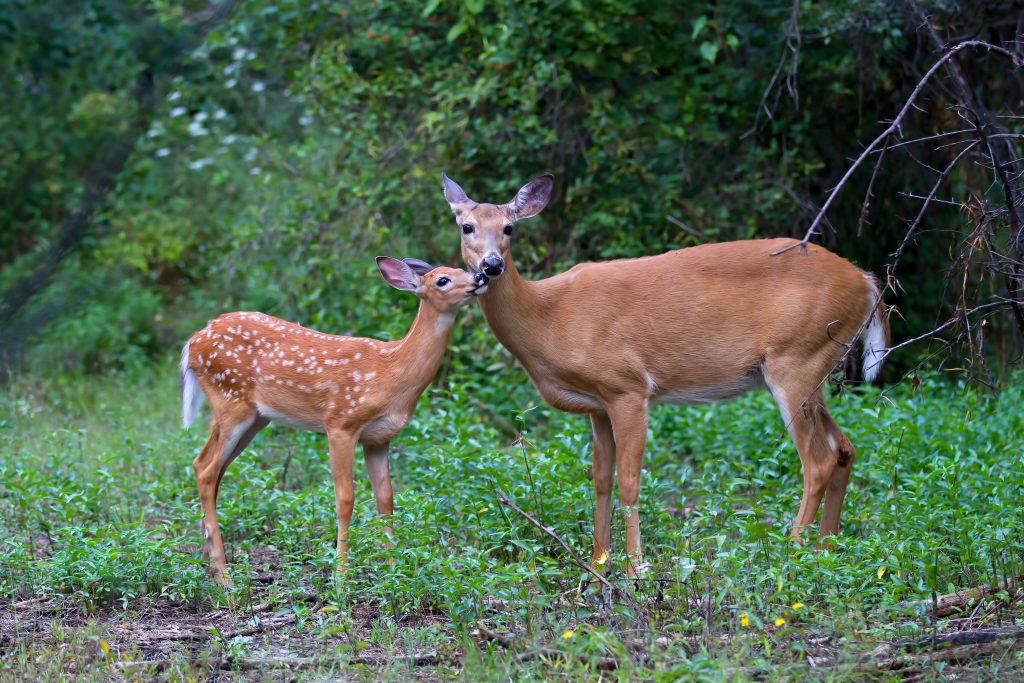
White-tailed deer (Odocoileus virginianus) are one of the major causes of damage and destruction of the home landscape. Despite loss of habitat due to development, deer populations have expanded rapidly in suburban areas as they are able to quickly adapt to the changing environment. Deer have been documented to consume virtually any vegetation in their quest to survive. A multipronged approach is required to minimize the damage and destruction of our landscape plantings by deer. Repellants and fencing can both be useful deterrents to deer when used properly. The mainstay to managing the battle against deer destruction is the planting of those trees, shrubs, groundcovers, bulbs, perennials and annuals that are not favored by the deer in your area.
Physical Barriers
- Fencing- In order to exclude deer, an 8-foot-high sturdy fence or ideally a double fence is required. This can be an extremely expensive option and not always aesthetically pleasing but should be considered in important planting beds in your yard.
- Plastic Mesh or Netting–Heavy-duty plastic mesh netting can be quite cost effective and is fairly easy to work with. If there is one particular plant in your landscape that the deer find particularly appetizing, you may find that it’s more economical to build a cage around that individual plant. Simply drive a few stakes into the ground and surround those securely with mesh.
Deterrents
- Results are variable so some experimentation may be required to determine what works best for you.
- Sprays and granules to be applied on foliage or around plantings.
- Consider purchasing a few different types of repellants and switch repellants intermittently as deer may acclimate to a single type.
- Natural-based repellents made from ingredients like dried blood, food products, predator urine or bio-solids: Deerbusters, Deer-Off, Deer-Away, Liquid Fence, Milorganite, Plantskydd, Scoot Deer, or Bobbex.
- Chemical-based materials: Tree Guard, Thiram, Defiant, and Repellex.
- Most spray-on deer repellants tend to diminish in effectiveness with precipitation and should be reapplied.
- Deer are quick learners; if they encounter a treated plant early in the year that has been rendered distasteful, they tend to avoid that during next visits.
- Letting your dog out in the yard can also help deter deer.
Some knowledge of the life cycle of deer can be useful in a seasonal approach to keeping deer damage at tolerable levels:
- Mid-April to June: Does give birth and require more food. Newly emerging herbaceous growth, emerging buds and new growth on trees and shrubs are particularly vulnerable. Spray repellants.
- July to Mid-August: There are more deer-fawns are growing. Spray repellant weekly on herbaceous material and monthly on woody plants.
- Late August to December: Bucks begin rubbing antlers on tree trunks, the peak of this activity occurring in November. Put up trunk guards to protect trees. Deer may spend more time in the woods eating acorns and other wild food stuffs and less time raiding the garden so less repellant may be required. As natural food sources decline and hard frost kills herbaceous material, deer may switch to woody plants in your landscape. Make sure to install temporary fencing around selected plants and use repellants before the first hard frost.
- January to April: Toughest time for deer to survive and they will browse on nearly any woody plant material. Check fences and respray repellants if weather warms. OK to remove tree guards in February as most bucks have shed antlers.
Deer Resistant Plants
Although no plant can be considered totally “deer proof”, deer are generally confused by aromatic plants and they tend to avoid eating thorny, prickly or hairy plants or those with sticky or bitter tasting sap. Regional deer populations have differing preferences and develop habits based upon conditions: plants not favored by deer in one region may be readily consumed in another. Because they can only reach so high, vegetation above 6 feet is generally safe, although trunks and stems from those plants may be damaged during rutting season.
The following is a list of plants that are generally considered least favored by deer and are organized into two groups: “Rarely Damaged”, “Rarely Severely Damaged”. These are the plants we designate as most resistant to deer browsing in this area.
Fullscreen Mode






